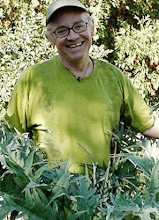
Compost Bin in the making

 Make the notch to fit the board you are using
Make the notch to fit the board you are using Planting board to make beet rows
Planting board to make beet rows Beet seed and radish marker seeds
Beet seed and radish marker seeds
 Covering the seed with potting soil for easy germination
Covering the seed with potting soil for easy germination
 Back side of carpet showing hole and side cut
Back side of carpet showing hole and side cut Top side
Top side Barriers in place in planted rows of broccoli
Barriers in place in planted rows of broccoli
Our spring is moving right along. The second crop of bunnies is out and about and the season's first mosquito found my arm yesterday and had a quick snack. What little rain we had this week really did not make much of a difference to growing plants. A good soaking would be appreciated.
Planting continued this week with beets, a white and a cylindrical variety, and I also positioned the cucumber trellis so I could plant around it. Cucumbers will not be started for a while yet but having the trellis in place marks that spot in the garden and I can plant lettuce in that space. Broccoli raab transplants along with lettuce were also transplanted under another trellis and with the spinach and arugula fast approaching maturity it is time to set up a compost bin.
The compost bin will be filled with any and most vegetative materials and because of the way it is built will grown as it is filled. The boards are three feet long and notched so that the bin stacks like "Lincoln logs" (to date myself). I usually have several bins and will sift the material from last year and re-compost the materials that did not completely break down. Six foot fence material is good stock to use to make this kind of bin.
Beets were planted in short rows, 6ft., and I mark the rows again with radish seeds. I also cover the seed with potting soil to allow for better water retention and an easier way for the seed to break through as my soil has a tendency to crust and make seed eruption difficult. The pictures show my procedure. Some thinning will be necessary after germination. The radishes will be allowed to grow to maturity as they are much faster than the beets
I also planted broccoli. We removed carpet from one of the bedrooms and it was just perfect for making root maggot barriers for my broccoli transplants. I cut 6 inch squares and punched a hole in the center and cut from the hole to the side. I place these around the stem of the transplants and they do a fine job of protecting from root maggots which are hard to deter now that a range of pesticides that dealt with them is no longer available. I have used this method in the past with good success and the broccoli plants don't seem to mind the pads. The pads are tough and will last a long time. However, no sooner than I got the row planted but a white cabbage butterfly was observed hovering around the plants. That's when the butterfly net is hung in the garden. It is tough to net all these pests but each one removed is a whole generation of eating machines that will not be around to feast on my plants. This week's video shows the planting for the broccoli and the application of the carpet root maggot barrier.
Tomato planting time is fast approaching as the ground warms. We use a post and string method to grow the tomato crop vertically so look forward to that process in the next post.
Happy Gardening

No comments:
Post a Comment